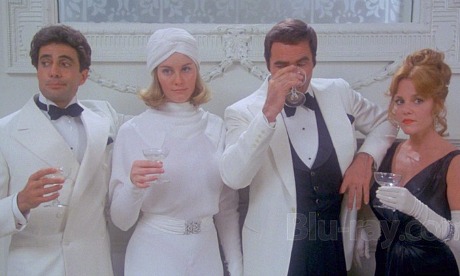A clear indication of the weakened state of the 1.85 fascist cabal is their odd silence about the 1.66 aspect ratio used for the just-released Bluray of Peter Bogdanovich‘s At Long Last Love (’75). As I believe in 1.66 as an eternal idea in the mind of God, I’m naturally delighted that this notorious clunker has been released in this format. The boxier the better, I say; especially for a film that sought to revive the spirit of 1930s musicals, when 1.37:1 was the rule. But I’m not aware of any historical justification for 1.66 being used for this 1975 film. Every stateside film was being shot in 1.85 in the ’70s except when otherwise specified (Stanley Kubrick‘s Barry Lyndon, etc.) and/or in the case of European films, and by ’75 every theatre in the U.S. was working with 1.85 aperture plates.

But the 1.85 crowd is saying nothing. You know why? One, they have no power — the heyday of applying lockstep 1.85 aspect ratios to Blurays is over and they know it, and they’re figuring it’s better to shut up rather than make waves. And two, Bogdanovich wanted 1.66 and they know it would be a losing battle to argue otherwise. His film, his call. So they’re playing it cool and quiet and letting it go. They’re hiding in tall grass.
“A couple of years ago a friend called to tell me that Netflix was streaming At Long Last Love on their system,” writes Bogdanovich on Indiewire. “I decided to take a look at it [and] I quickly began to realize that it was quite a different version than either the theatrical or the TV editions. Scenes and sequences that I had removed were back in; scenes I had left in were out; some of the song numbers were shortened, and some were lengthened. It was an edit that, if anything, was much closer to the very first preview cut which we had discarded in dismay. But it was sharper, better. In fact, it was the best version of the movie I had ever seen. And I loved it!
“Where on earth had this come from? I got in touch with Schawn Belston in the editorial department at Fox, and asked him a myriad of questions, to which he answered that he’d get back to me shortly after researching the issue.
“Well, eventually I was able to piece together what had happened: A man named James Blakely had been in charge of the Fox editorial department for something like 50 years, and he had passed away just a couple of years before. It seems that as a youngster he had been involved as a performer in a number of stage musicals, and that he was a die-hard fan of Cole Porter‘s songs. Obviously, he had liked the dailies of our film as they came in, and was apparently less than pleased with the editing we did on any of the versions.
“After the shouting had died down, it looks like he went about restructuring the movie, following the original script, specifically making sure that the storyline of the characters was clear and that extraneous numbers were deleted, but relevant songs reinstated or expanded. When he was happy with the result, he turned that version over to distribution. And his cut was being seen (on TV and cable) as early as 1979, less than four years after the initial release. So, all those times people came over to me and praised the film they had seen, they were not referring to any cut of mine, but to Jim Blakely’s!
“Now, of course, Blakely never told anyone what he had done because contractually I had final cut so his actions officially put the studio in breach. Well, I called 20th Century Fox chairman Jim Gianopulos, who is a friend, and told him the whole story. He was as amazed as I had been. ‘You mean there’s a cut of the picture you didn’t control or approve and you like it?!’ Yes, I said. ‘Well,’ he responded, accurately, ‘that’s one for the history books!'”









